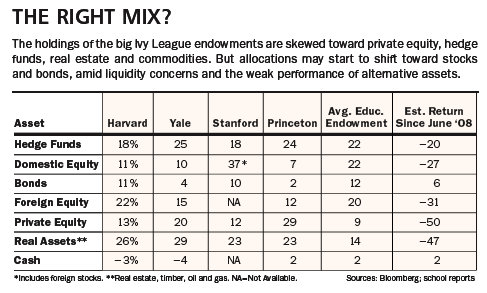haha
Give me a museum and I'll fill it. (Picasso) Give me a forum ...
Big Squeeze on Ivy League Endowments - Barrons.com
Barron's has an intersting article on university endowments this weekend. It might take a sub to see it. If so, maybe someone with more web skills than I can find another free location.
What caught my eye is that these endowments are intended to be perpetual, yet they must disburse an average of 5% annually. So in a sense they are in the position of a young ER who chooses a 5% withdrawal rate.
Then are in the active withdrawal phase, but they do not intend to be in drawdown. The big private ones- Harvard, Yale, Princeton, Stanford-are are quite diversified, but employ almost no fixed income (other than perhaps aggressive hedge fund fixed income strategies).

If they were using an approach similar to the lifecycle espoused by FAs etc, they would need at least 50% bonds. The article points out that theses funds have had a tough time the last few years. [Yale's] "Swensen acknowledged that "diversification isn't going to help you in the midst of a financial crisis, or at least the type of diversification that you see in institutional portfolios like Yale's." He added, "I'm not sure that the crisis has caused us to conclude that we would do things differently, but it certainly highlighted the importance of liquidity."
Don't know what all this might mean for the individual retiree, but it is perhaps food for thought.
Ha
Barron's has an intersting article on university endowments this weekend. It might take a sub to see it. If so, maybe someone with more web skills than I can find another free location.
What caught my eye is that these endowments are intended to be perpetual, yet they must disburse an average of 5% annually. So in a sense they are in the position of a young ER who chooses a 5% withdrawal rate.
Then are in the active withdrawal phase, but they do not intend to be in drawdown. The big private ones- Harvard, Yale, Princeton, Stanford-are are quite diversified, but employ almost no fixed income (other than perhaps aggressive hedge fund fixed income strategies).

If they were using an approach similar to the lifecycle espoused by FAs etc, they would need at least 50% bonds. The article points out that theses funds have had a tough time the last few years. [Yale's] "Swensen acknowledged that "diversification isn't going to help you in the midst of a financial crisis, or at least the type of diversification that you see in institutional portfolios like Yale's." He added, "I'm not sure that the crisis has caused us to conclude that we would do things differently, but it certainly highlighted the importance of liquidity."
Don't know what all this might mean for the individual retiree, but it is perhaps food for thought.
Ha
